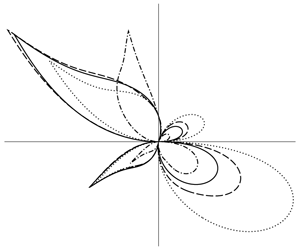Published online by Cambridge University Press: 05 December 2019

Large-scale coherent structures are present in compressible free shear flows, where they are known to be a main source of aerodynamic noise. Previous studies showed that these structures may be treated as instability waves or wavepackets supported by the underlying turbulent mean flow. By adopting this viewpoint in the framework of triple decomposition of the instantaneous flow into the mean field, coherent motion and small-scale turbulence, a strongly nonlinear dynamical model was constructed to describe the formation and development of coherent structures in incompressible turbulent free shear layers (Wu & Zhuang, J. Fluid Mech., vol. 787, 2016, pp. 396–439). That model is now extended to compressible flows, for which the coherent structures are extracted through a density-weighted (Favre) phase average. The nonlinear non-equilibrium critical-layer theory for instability waves in a laminar compressible mixing layer is adapted to analyse coherent structures in its turbulent counterpart. The strong non-parallelism associated with the fast spreading of the turbulent mean flow is taken into account and found to be significant. The model also accounts for the effect of fine-scale turbulence on coherent structures via a gradient type of closure model which now allows for a phase lag between the phase-averaged small-scale Reynolds stresses and the strain rates of coherent structures. The analysis results in an evolution system comprising of an amplitude equation, the critical-layer temperature and vorticity equations along with the appropriate initial and boundary conditions. The physical processes of acoustic radiation from the coherent structures are described by examining the far-field asymptote of the hydrodynamic fluctuations. We demonstrate that the nonlinearly generated slowly breathing mean-flow distortion radiates low-frequency sound waves. The true physical sources are identified. Equivalent sources in a Lighthill type of acoustic analogy context also arise, but they cannot be fully determined before the acoustic field is calculated, in which sense the radiated sound waves act back on the source. The numerical solutions to the evolution system show that coherent structures attenuate nonlinearly and their vorticity field rolls up to form the characteristic rollers. A study is also made of coherent structures represented by modulated wavetrains consisting of sideband modes, in which case nonlinear interactions generate components with frequencies that are combinations of those of the dominant modes. These components, especially the difference-frequency one, acquire significant amplitudes. Finally, the directivity and spectrum of the emitted acoustic field are calculated for both cases where the coherent structures consist of discrete, and a continuum of, sideband modes.